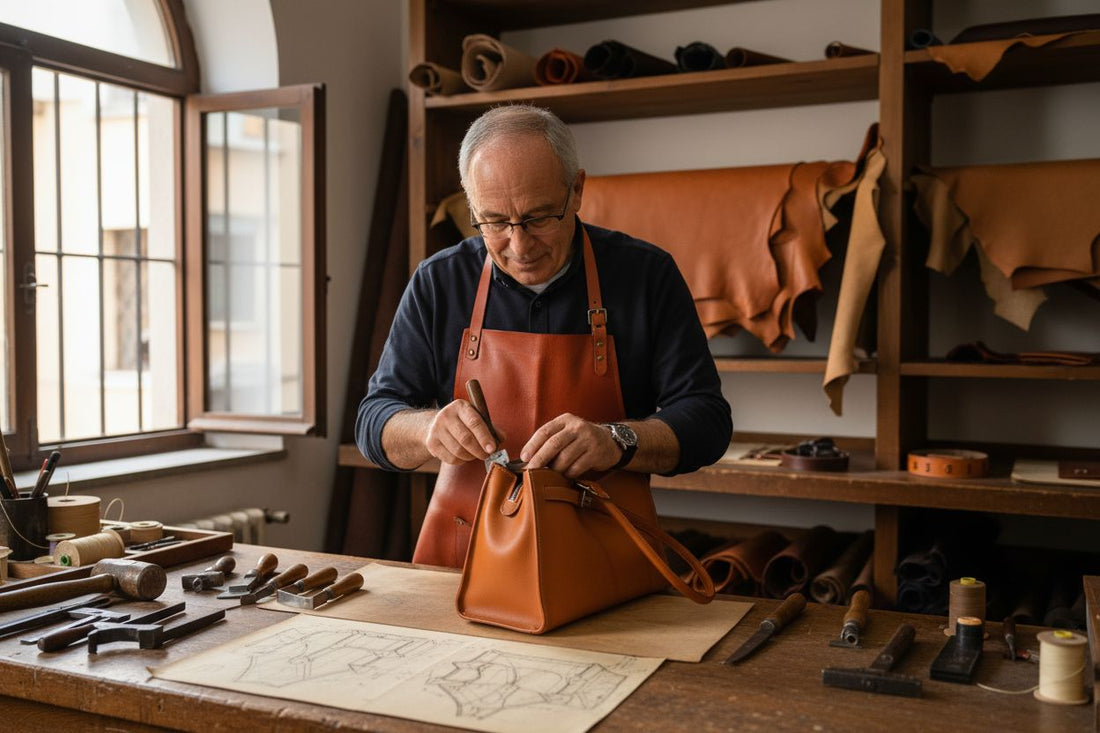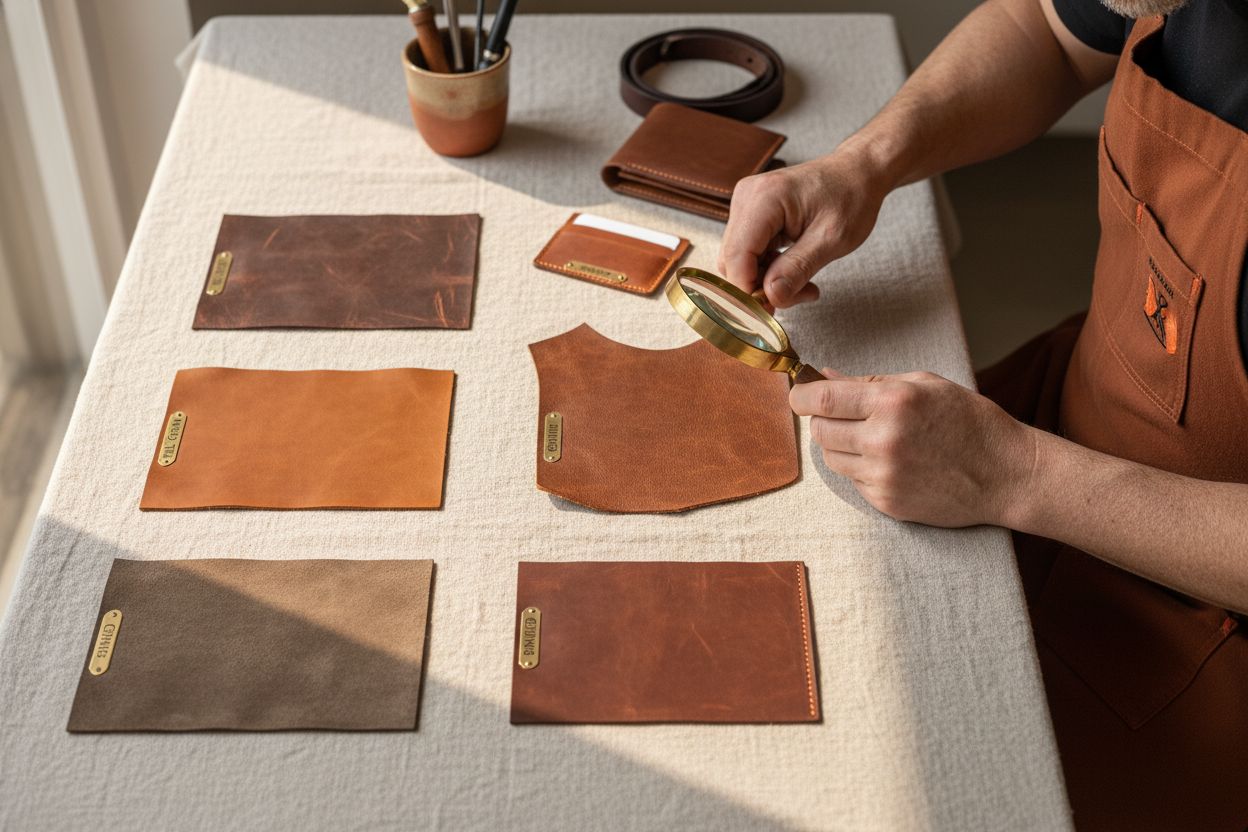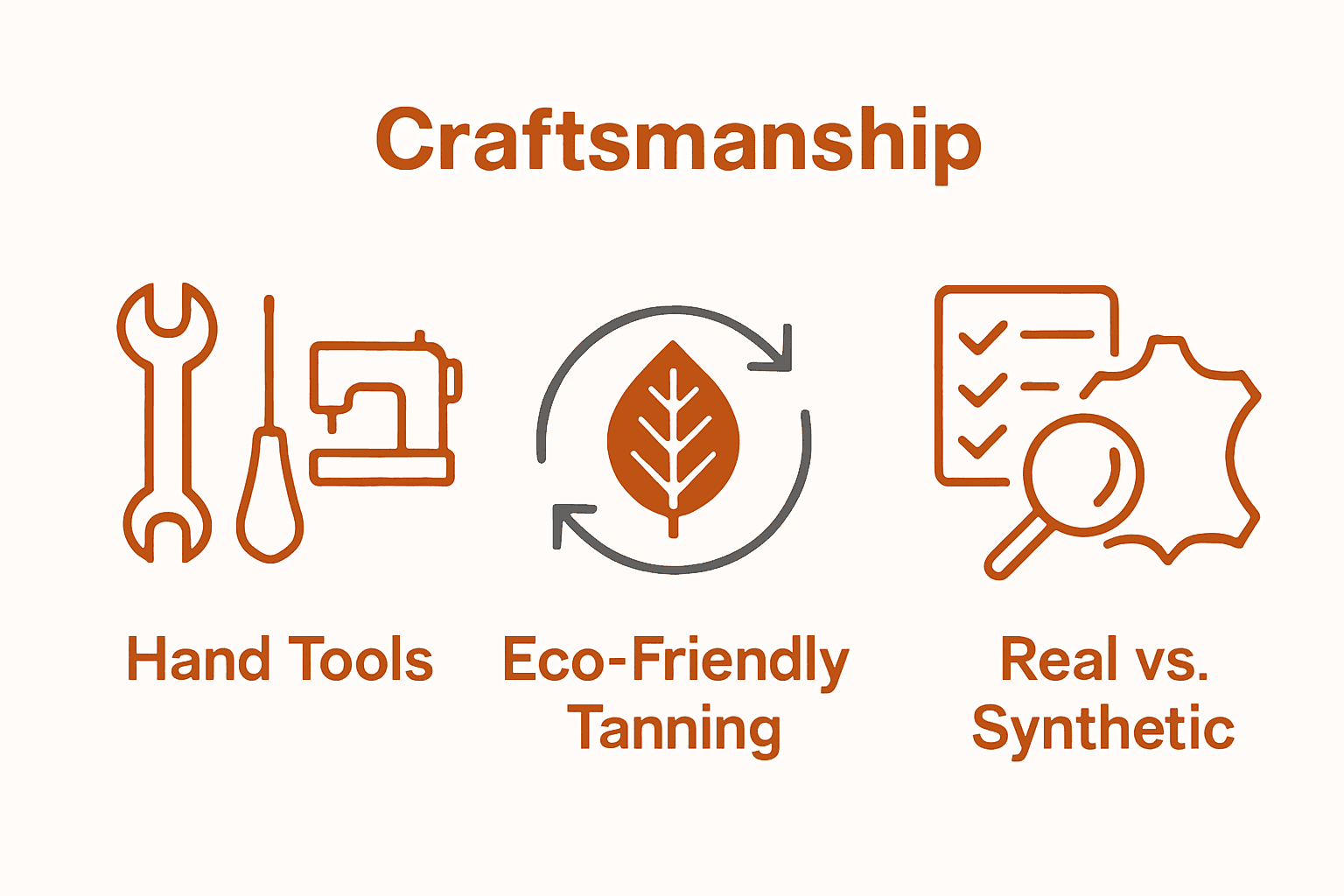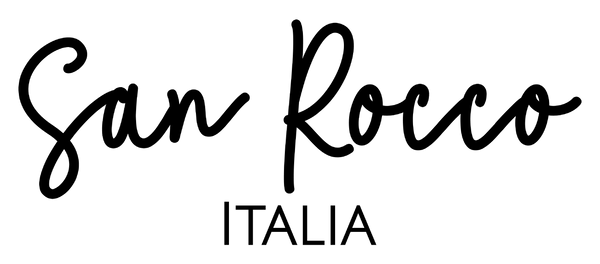
Complete Guide to Artisan Leather Craftsmanship
Share
Did you know that over 95% of luxury Italian leather goods are still handcrafted using time-honored techniques? This quiet dedication to craft ensures each piece tells its own story, blending tradition, precision, and artistry. For those who want more than mass-produced fashion, understanding artisan leather craftsmanship opens the door to a world where every detail matters and quality truly stands apart.
Key Takeaways
| Point | Details |
|---|---|
| Artisan Craftsmanship | Artisan leatherwork emphasizes traditional techniques and quality materials, resulting in unique, functional art pieces. |
| Leather Types | Understanding the distinctions among leather grades is essential for making informed purchasing decisions and selecting high-quality products. |
| Sustainability and Ethics | Modern artisans prioritize environmental responsibility and fair labor practices, ensuring the entire production process values quality and tradition. |
| Consumer Awareness | Education on leather terminology is crucial, as misleading marketing can lead to poor purchasing decisions regarding leather quality. |
Table of Contents
- Defining Artisan Leather Craftsmanship
- Types Of Leather And Their Distinctions
- Traditional Techniques And Skilled Processes
- Italian Heritage And Regional Expertise
- Quality, Sustainability, And Ethical Factors
- Common Mistakes When Selecting Leather Goods
Defining Artisan Leather Craftsmanship
Artisan leather craftsmanship represents a profound fusion of traditional skill, meticulous technique, and deep respect for material quality. Artisan leatherwork is far more than manufacturing - it’s a time-honoured practice where skilled craftspeople transform raw leather into exquisite, functional pieces through precision and passion.
According to research from European leather industry reports, this craft involves a highly trained workforce committed to maintaining exceptional quality standards. The artisan’s approach goes beyond mass production, focusing instead on:
- Preserving traditional techniques passed through generations
- Selecting premium leather materials with careful consideration
- Executing each piece with extraordinary attention to detail
- Creating products that reflect individual skill and artistic expression
Traditional techniques like those found in gainerie, a French métier d’art, showcase the intricate nature of leather craftsmanship. Learn more about authentic leather identification in our comprehensive guide. These craftspeople use specialized methods such as hot-tool gilding and work with luxurious leather types like goatskin, creating rigid objects that are both functional and aesthetically remarkable.
At its core, artisan leather craftsmanship represents a commitment to quality over quantity - a celebration of human skill that transforms simple materials into timeless, beautiful objects that tell a story of tradition, expertise, and uncompromising standards.
Types of Leather and Their Distinctions
Leather is a remarkably diverse material, with each type offering unique characteristics that make it suitable for different purposes. Leather grades range from premium to basic, each representing a different level of quality and performance in crafting exceptional pieces.
According to research on leather classifications, six primary leather grades exist, each with distinctive properties:
- Full Grain: The highest quality, retaining the entire natural grain
- Top Grain: Slightly modified, with surface imperfections removed
- Genuine Leather: A lower-grade composite material
- Split Leather: Made from the fibrous part of the hide
- Bonded Leather: Manufactured from leather scraps and adhesives
- Suede: Soft, napped leather with a luxurious texture
Our comprehensive guide on authentic leather provides deeper insights into these distinctions. According to expert sources on animal leathers, different animal hides offer remarkable variations:
- Cowhide: Versatile and widely used
- Goat Leather: Remarkably durable and water-resistant
- Sheepskin: Incredibly soft and lightweight
- Pig Leather: Highly breathable
- Buffalo Leather: Exceptionally tough with a rugged texture
Understanding these leather types allows discerning buyers to select materials that perfectly match their aesthetic preferences, functional requirements, and quality expectations. Each leather tells a unique story of craftsmanship, origin, and potential.

Here’s a comparison of the main leather types, their sources, and core characteristics:
| Leather Type | Animal Source | Key Characteristics |
|---|---|---|
| Full Grain | Cow, Buffalo | Premium quality Natural grain Highly durable |
| Top Grain | Cow, Buffalo | Slight surface correction Smooth finish Less natural feel |
| Genuine Leather | Various | Composite layers Affordable Less durability |
| Split Leather | Cow, Pig | From fibrous inner hide Lower strength Used for suede |
| Suede | Cow, Goat, Pig | Soft texture Napped finish Not water resistant |
| Bonded Leather | Offcuts (mixed) | Made with scraps and adhesive Low cost Least durable |
| Goat Leather | Goat | Lightweight Water-resistant Supple feel |
| Sheepskin | Sheep | Very soft Lightweight Warm |
| Pig Leather | Pig | Breathable Distinctive grain Flexible |
| Buffalo Leather | Buffalo | Tough Rugged texture Heavy-duty uses |
Traditional Techniques and Skilled Processes
Artisan leather craftsmanship is a delicate dance of time-honoured techniques and extraordinary manual skills that transform raw materials into exceptional pieces. Traditional leatherworking represents an intricate blend of precision, artistic vision, and generational knowledge passed carefully between master craftspeople.
According to research on European leather craftsmanship, the leather sector maintains a sophisticated balance between preserving traditional methods and embracing modern innovations. This nuanced approach ensures that craftsmanship evolves while maintaining its core integrity.
Specialized techniques showcase the depth of leather artistry. Gainerie, a remarkable French leather crafting method, demonstrates extraordinary skill through processes such as:
- Creating rigid leather-covered forms
- Executing precise edge-turning techniques
- Developing flush seamwork
- Implementing decorative tooling methods
- Performing intricate embossing
- Executing hot-tool gilding with exceptional precision
For deeper insights into authentic leather identification and techniques, explore our comprehensive guide. These meticulous processes represent more than technical skills - they are a form of artistic expression where each movement reflects generations of accumulated wisdom, transforming leather from a simple material into an object of exceptional beauty and functionality.
Italian Heritage and Regional Expertise
Italian leather craftsmanship stands as a global benchmark of excellence, representing centuries of refined skill, cultural pride, and unparalleled attention to detail. Each region across Italy contributes its unique perspective, creating a rich tapestry of leather artistry that has captivated the world for generations.
According to research on Italian leather heritage, remarkable brands like Poltrona Frau exemplify the pinnacle of craftsmanship. Their meticulous 21-step tanning process for full-grain leather demonstrates an extraordinary commitment to quality, with an impressive 95% of production completed through handcrafted techniques.
Regional expertise reveals the depth of Italian leather traditions. Our comprehensive guide to Italian handbag craftsmanship explores these nuanced techniques. Notable examples include:
- Florence: Renowned for intricate woven leather techniques
- Milan: Leading in high-fashion leather design
- Naples: Specializing in sophisticated leather finishing
- Tuscany: Home to traditional vegetable tanning methods
- Venice: Masters of delicate leather embellishments
Specific artisans like Bottega Giotti from Florence continue a remarkable family tradition dating back to the early 20th century. These craftspeople specialize in intrecciato (woven leather) techniques, preserving regional craftsmanship that transforms leather into living historical artifacts. Their approach represents more than manufacturing - it’s a cultural narrative passed through generations, celebrating human skill, creativity, and an unwavering commitment to exceptional quality.
Quality, Sustainability, and Ethical Factors
Ethical leather craftsmanship represents a holistic approach that extends far beyond aesthetic beauty, encompassing environmental responsibility, worker welfare, and cultural preservation. Modern artisans understand that true quality means considering the entire production ecosystem from material sourcing to final product creation.
According to European Union research on industrial sustainability, tanneries are increasingly investing in comprehensive social and environmental improvements. These efforts include:
- Implementing advanced pollution control technologies
- Utilizing renewable and sustainable input materials
- Balancing traditional heritage with innovative practices
- Ensuring fair working conditions for craftspeople
- Reducing environmental impact throughout production
Our comprehensive guide on authentic leather identification provides deeper insights into quality assessment. Remarkably, traditional crafts like gainerie in France are now officially recognized as a métier d’art, highlighting how cultural heritage and sustainable practices are intrinsically linked.
The pursuit of ethical leather craftsmanship means valuing transparency, prioritizing human skill, and respecting both environmental and cultural ecosystems. Each carefully crafted piece becomes more than a product - it’s a statement of commitment to quality, sustainability, and the preservation of remarkable artisanal traditions that have been refined over generations.

Common Mistakes When Selecting Leather Goods
Leather purchasing requires more than just aesthetic appreciation - it demands understanding subtle nuances that distinguish exceptional quality from mediocre products. Consumers often make critical errors that compromise their investment, believing misleading marketing claims or misinterpreting product descriptions.
According to research on leather classifications, many buyers are easily misled by marketing symbols and terminology. Consumers frequently misunderstand key terms like:
- “Genuine Leather”: Often implies lower quality, not authenticity
- Hide-shaped icons that suggest quality without substantive meaning
- Misleading labels that overstate product characteristics
- Marketing language designed to obscure actual leather grade
Learn more about identifying authentic leather in our comprehensive guide. Additionally, research highlights significant confusion between real leather and alternative materials like vegan or reconstituted leather. Buyers often mistakenly expect these alternatives to possess the same durability, texture, and longevity as genuine leather.
Understanding these potential pitfalls allows discerning buyers to make informed decisions. The key is education: learning to recognize quality markers, understanding leather grades, and developing a critical eye for craftsmanship that goes beyond superficial marketing claims. True leather selection is an art of informed discernment.
Discover the True Meaning of Artisan Craftsmanship with San Rocco Italia
Are you seeking leather goods that truly reflect the artistry, quality, and heritage described in our Complete Guide to Artisan Leather Craftsmanship? Many shoppers risk disappointment by choosing items that only look good at first glance, unaware of misleading grade labelling or mass-produced shortcuts that compromise both beauty and longevity. At San Rocco Italia, we address these very challenges by offering a curated collection of luxury handbags and accessories, each crafted from premium full-grain leather using the traditional methods celebrated in the article. Authenticity, skill, and timeless design are not just promises but visible in every piece.

Why settle for less when you can own a piece of Italian artistry? Explore our story and shop with confidence at San Rocco Italia, where you will find accessories that honour craftsmanship, transparent sourcing, and genuine materials. Start your own legacy of style and substance today. If you want to deepen your understanding of quality leather, visit our comprehensive guide on identifying authentic leather. Each visit brings you closer to acquiring not just a product, but a tradition. Take the next step now and invest in enduring excellence.
Frequently Asked Questions
What is artisan leather craftsmanship?
Artisan leather craftsmanship is the traditional practice where skilled craftspeople transform raw leather into beautiful, functional pieces. It emphasizes preserving techniques, selecting high-quality materials, and creating unique products through meticulous attention to detail.
What are the different types of leather grades?
There are six primary leather grades: Full Grain, Top Grain, Genuine Leather, Split Leather, Bonded Leather, and Suede. Each grade has its unique characteristics regarding quality, durability, and aesthetic appeal, making them suitable for specific purposes.
What traditional techniques are used in artisan leather craftsmanship?
Artisan leather craftsmanship employs various traditional techniques such as edge-turning, decorative tooling, embossing, and hot-tool gilding. These methods require exceptional skill and transform leather into unique, high-quality items.
How can you identify authentic leather?
Authentic leather can be identified by examining its texture, smell, and flexibility. Additionally, understanding the various grades and classifications of leather helps in distinguishing genuine leather from synthetic or lower-quality alternatives.


